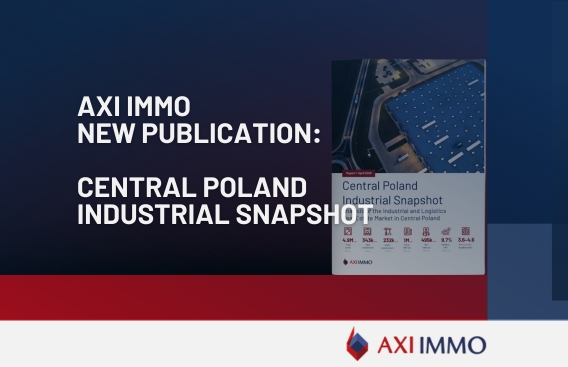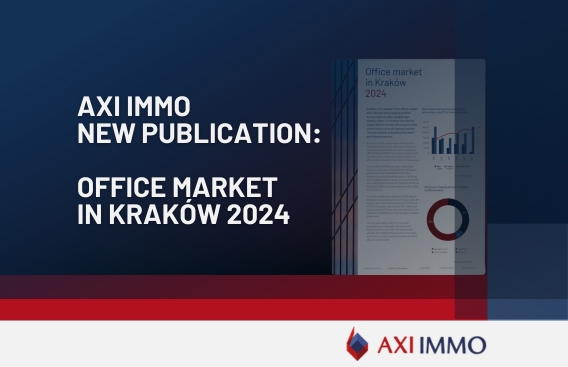Report: Warehouse Market in Poland in 2017 and Prospects for 2018
Report: Warehouse market in Poland in 2017 and prospects for 2018. AXI IMMO experts present the summary report on the warehouse market in Poland in 2017.

The Polish warehouse market remains in great shape. New year-to-year records are being broken. Gross demand amounted to 4 million sq m, of which 75% was made up of new lease agreements and expansions. This is a 32% improvement compared to 2016. High demand side results are due to the accelerating economy, including internal consumption growing month by month and an increase in investment by companies. Developers responded quickly to high demand from tenants, resulting in 2.36 million sq m delivered on the market and 1.39 million sq m under construction at the end of 2017. The high level of absorption caused the vacancy rate decrease to 4.5% according to the report summarising 2017 in the warehouse space market in Poland prepared by AXI IMMO experts.
| Download: | Report: Warehouse market in Poland in 2017 and prospects for 2018 | Download for free: PDF|1939 KB |
Industrial property – the most profitable investment product
Stable growth for several years and the prominent position of the Polish warehouse market in Europe means that investors are willing to place their capital in the industrial segment. Logistic portfolios and large BTS projects leased to valuable tenants are especially sought after. In 2017, the total value of transactions in the industrial segment in Poland amounted to EUR 880 million. In comparison with 2016, this is a result of over 14% better. The sale of the Logicor portfolio, including 28 properties in Poland with an area of 900,000 sq m, to China Investment Corporation (CIC) largely contributed to this result.
“The pan-European trend of yield compression also applies to Polish real estate, although logistics and industrial products in Poland are still less expensive than in Western European countries. Average capitalisation rates depending on the type of facility are between 6.5% and 7.5%, with the exception of individual BTS facilities leased for international brands – comments Renata Osiecka, Managing Partner at AXI IMMO. Warehouse products will remain of interest to investors, but the question is: how will new tax regulations on the method of settling lease costs and the retail tax affect the logistics industry and the sector’s assessment by investors.” – adds Renata Osiecka.
New record broken, thanks to large transactions for e-commerce
Last year, over 4 million sq m was leased, of which 75% was made up of new lease agreements and expansions. For the third year in a row, demand broke new records. The result for 2017 is 32% higher compared to the previous year and as much as 61% higher than in 2015. The decisive influence on such an impressive result was due to large transactions, which accounted for almost 30% of new lease agreements.
“The macroeconomic factors that caused such high demand are the increase in internal consumption, production and exports as well as the increase in investment expenditure by companies. This had a direct impact on the warehouse sector in the form of increased demand for space from logistics operators and e-commerce companies.”– comments Anna Głowacz, Head of Industrial – Leasing Agency.
The demand leader in the past year was Central Poland, where 960,000 sq m was leased, which is 243% more in this region than in the previous year. The regions of Warsaw (950,000 sq m) and Upper Silesia (860,000 sq m) also achieved impressive results.
“Central Poland, Warsaw and Upper Silesia together account for 68% of gross demand. However, Central Poland is the location chosen by companies as the main logistics hub and it is well populated by e-commerce companies. Warsaw is attractive due to its huge internal market and new locations along expressways and the ring-road. Upper Silesia, aside from the advantage of its large market, is attractive due to its large labour market and relatively greater availability of workers.” – adds Anna Głowacz.
Among the new, growing locations, the Lubuskie province deserves recognition, where more than 150,000 sq m was leased. Due to the proximity of the border with Germany, the location is favoured by logistics and production companies that distribute mainly to Western Europe.
Large lease agreements for BTS investments dominated among clients from the e-commerce sector and retail chains. By industry, as in previous years, logistics operators had the largest market share (32%), followed by retail chains (15%), e-commerce (15%) and automotive (6.8%). It is worth noting, however, that the largest lease agreements were in the e-commerce sector, involving companies that operate only in the Internet, such as Amazon and Zalando, but also retail chains are investing in new logistic centres for their on-line channel.
Supply dominated by large BTS investments
The elevated level of activity among tenants did not remain unnoticed by developers who, to meet the requirements of tenants, opened new logistics parks and built BTS projects. In 2017, a total of 2.36 million sq m was delivered on the market, which is 89% more than in the previous year. The largest amount of new space was completed in the Warsaw region (478,000 sq m), with Upper Silesia in second place (388,000 sq m) and Szczecin in third place where new supply exceeded 320,000 sq m.
The total supply of modern space in Poland at the end of 2017 amounted to 13.3 million sq m. The supply structure was dominated by BTS and pre-let projects. At the end of the year, 1.39 million sq m was under construction of which 30% was made up of speculative investments. The share of speculative investments remains stable, oscillating between 22% and 30% during the year. BTS investments are being built most intensively and in their greatest number in Upper Silesia (360,000 sq m), then in Central Poland (301,000 sq m) and Warsaw (243,000 sq m). The highest number of speculative projects are also under construction in Upper Silesia.
“In addition to major warehouse markets, developers are launching projects in new locations such as Kielce, Bialystok and Słubice. The higher availability of staff, often no offer of A-class facilities in the region and increasingly better road infrastructure are the advantages that developers want to exploit to attract tenants.”– comments Anna Głowacz.
Among developers, the largest share in new supply, as last year, was taken by company Panattoni Europe (53%), followed by the developers Goodman (14%), P3 (8%), MLP and Hillwood (5-6%).
Decrease in warehouse space availability, despite the high activity of developers
At the end of 2017, the vacancy rate amounted to 4.5%, a drop of 1.7 percentage points year on year. Despite the substantial number of new investments, the availability of free space immediately remained at a low level. New projects are often rented at over 80-90% before the end of construction, even if the project was started speculatively.
At the end of the year, there was virtually no space available in the regions: Central Poland, Szczecin, Tricity and Bydgoszcz. The highest availability was near Krakow (13.8%) and Poznan (8.0%). The largest drop in free space was recorded in Tricity, where the vacancy rate fell from 13.9% to 1.3% at the end of 2017. This year, the vacancy rate will remain at a low level in most locations, while periodic increases should not exceed 2-3% nationally.
Rent rates are still competitive compared to Western Europe, but with an upward trend
From the second half of the year, there was an upward trend in the level of rents in selected locations. This increase in rates is due to higher costs of acquiring land, but also the higher costs of construction materials and investment-related costs.
The most attractive effective rates were possible to obtained near Warsaw and Poznan (1.9-2.4 EUR/sq m). An average increase of 0.2 euros was visible in Upper Silesia and Wroclaw. Rates in Lodz were effectively maintained throughout the year at a stable high level of 3.0 EUR/sq m. In new locations such as Szczecin, Zielona Góra and Kielce, effective rates remain within the mid-market range, i.e. (2.3-2.6 EUR/sq m).
This year, rates will remain at a stable level, while it will be more difficult to obtain attractive terms for contracts shorter than 5 years. The rental market is adapting to the investment market, where medium and long-term contracts are required.
Good forecast, despite the low labour force availability
2018 may be as successful as 2017. The GDP forecast for Poland is above 4.0% and for the entire EU 2.5%, which is a good sign for the warehouse sector. The PMI index is also growing, which means an increase in production and investment outlays by companies present in Poland.
The main threat to the further dynamic growth of the warehouse and production sector in Poland is the low availability of workers in most locations, their high rotation and rising labour costs. This is a problem especially in seasonal sales peaks when the demand for workers grows two or three times.
Indirectly, staff shortages in the construction industry can also influence the warehouse market. Generali contractors will extend the delivery date of facilities. The average duration of an investment may be prolonged by 2-3 months.
Rental rates will show an upward trend due to the increase in the cost of purchasing land for investment and the higher costs of building materials and other investment-related costs.
On the demand side, the largest growth potential remains the e-commerce industry, whose development is a global trend. In Poland, this sector may also benefit from the new law prohibiting Sunday trading in shops.
Recent articles
14 April 2025
New Work expands in Warsaw with new serviced offices space at Metron building, AXI IMMO advises
Serviced offices at New Work in Warsaw, just steps away from Metro Wierzbno station.
9 April 2025
Central Poland Industrial Snapshot – Analysis of the industrial and logistics real estate market in Central Poland, AXI IMMO publication
High industrial take-up in Łódź region in 2024 driven by lease renewals
3 April 2025
AXI IMMO presents its analysis of the industrial & logistics market in Małopolska, southern Poland
Małopolska on developers' spotlight: more space for industrial and logistics on the horizon.
24 March 2025
Office market in Kraków 2024, Poland, publication by AXI IMMO, 2025 March – Analysis, trends, forecasts
Kraków is the leader of regional office markets – tenant activity is growing. AXI IMMO's special publication on Office market in Krakow in 2024, Poland includes an analysis of supply, demand, rental rates, as well as trends and forecasts on the Krakow office market in 2025 and 2026.



